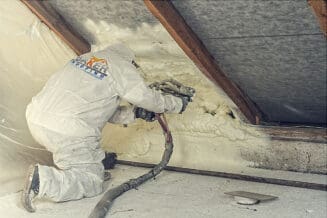
What is the Best Insulation for My Home?
When you see your heating and cooling costs rising, it may be time to look in your attic at the insulation. It could be an issue of your heat escaping through your ceiling and into your attic during the colder months. However, the reverse could be true in the summer; heat may be seeping in from your ceiling and displacing the cool air.
While nearly all houses can benefit from an exhaustive airtightness diagnostic service, most homeowners will find the cost is too high for the potential savings. In Texas, we spend most of our year trying to keep the cold air in the house, and, as we all know, the hottest part of any home is the attic. Attics in Texas homes reach temperatures in excess of 150°f, so you can see why it is so important to have the proper insulation in your house.
Types of Insulation
There are several types of insulation available and all with their pros and cons; here, we will just be focusing on only a few options. We will be looking at the difference between batt style and blown-in insulation. Also, we will compare the two primary materials used in these types of insulation, fiberglass versus cellulose.
Additionally, we will dive into the pros and cons of spray-in foam insulation and whether it is a good fit for your home.
Batt vs. Blown
Batt insulation has been around for the long haul and is probably the most commonly seen in older homes. This type of insulation is typically made of a fiberglass matt attached to a paper backing. The thickness will vary based on the R-value of the batting. The R-value is a measure of the resistance of heat flow through a given material. Batt is installed into the wall cavities between studs and between ceiling joists in the attic. Conversely, blown insulation is just like it sounds; it’s blown into the attic or wall cavities. Blown insulation can be various materials such as cellulose, fiberglass, or mineral wool.
Fiberglass vs. Cellulose
Fiberglass insulation has reigned as king for a very long time, but it has some significant drawbacks. Fiberglass has long been under scrutiny for health issues. Most people know that handling fiberglass will leave you itchy and full of fiberglass slivers, but the problems are much worse. Fiberglass has been shown to cause respiratory issues and may even be linked to cancer and DNA mutation, as some research suggests. It also may contain formaldehyde as a binder, and overtime, it is released into the air.
Cellulose insulation is a loose-fill material (blown-in) made up of primary recycled newspaper but also other forms of paper and cardboard. It is often treated with boric acid, which makes it both mold and insect resistant but also increases its fire resistance. Cellulose is more effective than fiberglass and requires about 22% less material to achieve the same R-value. Because cellulose is an extremely dense material, it is imperative that proper ventilation is ensured, and moisture barriers are used to keep moisture build-up from forming.
Spray-in Foam Insulation
Spray-in foam insulation is incredibly effective when properly applied to the right house. Foam insulation has a better R-value than batt or blown-in insulation, but it is not a DIY kind of project for sure. Problems will arise if the product is not mixed correctly, if it is unevenly applied, or used on a home that is not optimized for foam insulation.
Foam insulation encapsulates a space, meaning it creates an impenetrable air and moisture barrier when applied to the manufacture’s guidelines. However, because of this, not all HVAC systems will work well with foam insulation. Too large of a system could have adverse effects and actually be less effective and cause excessive moisture. It is wise to seek professional consultation to determine if your home would be a good fit for foam insulation. Foam insulation can greatly reduce your cooling costs, but there may be additional costs required.
Insulation Installation Costs
The cost of an insulation install is varied depended on the specifics of a job. Is this going to be installed in a new home, remodel, or is it going to be retrofitted? Will the original insulation need to be removed, or will the new product just be added on top to reach the desired R-value? Which insulation material will be used?
Cellulose is typically a cheaper material than fiberglass, and it also is more efficient as we discussed before; however, the installation could be more expensive if you are comparing blown-in to batt insulation installation.
Spray-in foam insulation is the most expensive option but also the most effective insulation for many houses. Remember, though; there are several other factors that could add to the cost of a foam insulation installation.
When you are ready to have your home properly insulated, it is crucial to consult a professional like Baker Roofing & Construction. We will come out and access your home and make recommendations as to what material, form, and process would most benefit you. Our priority is to ultimately make your home the best it can become from proper insulation to excellent attic ventilation and more. We strive to give our clients a complete system that works synergistically to achieve our goals of more efficient and ecofriendly homes across Texas.
Products We Embrace
When an eco-conscious company produces an effective product, it gets our attention here at Baker Roofing & Construction. For example, Greenfiber® loose-fill cellulose insulation is a wonderful, eco-friendly product. Made from 85% recycled materials and in low-energy manufacturing facilities, Greenfiber® insulation is free of formaldehyde, asbestos, glass fibers, and mineral wool, making this insulation one of the safest and eco-friendly options available today.
MORE than Just a Roofing Company!
Back to Blog